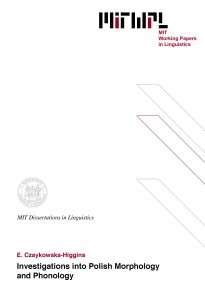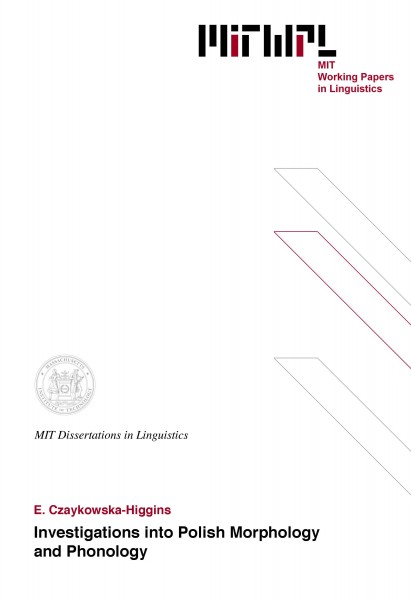Investigations into Polish Morphology and Phonology
E. Czaykowska-Higgins, 1988
This study investigates the relationship between morphology and phonology. It addresses two interrelated but distinct questions: first, what are the morphological devices and processes required to generate the input to the phonology, and second, how do the rules of the phonology interact with the morphological structure? Answers to these questions are provided by a detailed examination of the morphology and phonology of Polish. It is argues that morphology is distinct and separate from phonology, and that phonology operates on objects which are created by the morphology. The phonology consists of two distinct components: word-level and phrase-level phonology. The word-level component involves processes that apply word-internally and is organized into two blocks, one of cyclic and the other of non-cyclic rules. The phrase-level component involves processes not limited to the word.
The thesis is organized as a series of three studies of particular topics in Polish morphology and phonology. The first study is concerned with the morphological structure of Polish verbs. It is argues that the Polish verb has a four-part constituent structure, consisting of a Class-stem, a Verbalizing Suffix Stem, a Tense Marker Stem, and a Person/Number Stem. The Class-stem, which carries the lexical semantic content of the verb, is specified for membership in a particular inflectional class; inflectional and some derivational properties of a stem are predictable from class membership. It is proposed that word-formation rules which derive denominal or secondary imperfective Class-stems are conversion rules which change a stem’s class membership; these rules may involve concomitant affixation or phonological alternations. The discussion of verbs illustrates the fact that morphological structure is not necessarily isomorphic either with semantics or phonology. For example, Polish prefixes are argued to be phonological words, even though morphologically, they are included in the verb word.
The second study focuses on the cyclic phonological alternations commonly referred to as palatalizations. It is argued that most of the palatalization rules are morphologically, rather than phonologically, conditioned, but that they are nevertheless ordered in the cyclic component of the phonology. Several vowel alternations are shown to be lexically conditioned in that, although they apply in phonologically well-defined environments, they apply in only a subset of forms which meet their structural descriptions. Thus it is concluded that the phonology of Polish is governed by more idiosyncratic behaviour than previous research had assumed.
The third study deals with the processes associated with the orthographic nasal vowels of Polish. Taking into account recent work in hierarchical feature representations and underspecification theory, it is argued that the nasal vowels are underlying nasal dipthongs whose first member is a mid vowel and whose second member is a placeless nasal glide. The similar behavior of nasal glides and nasal stops is accounted for by assuming that nasal stops can lose their place of articulation specifications. Both the underlying and the derived placeless nasals receive place features by rules of assimilation or by redundancy rules. The nasal processes provide evidence for the noncyclic word-level component and the phrase-level component of the phonology.
Thesis Supervisor: Morris Halle
Title: Institute Professor
<br/>
Table of Contents
Chapter 1 Introduction 11
1 Morphology 13
1.1 Morphological Theory 14
1.2 Polish morphology 19
2 Phonology 23
2.1 Cyclicity 24
2.2 Lexical phonology and the ordering hypothesis 27
2.3 Polish phonology 34
3 The underlying consonant and vowel inventories 39
Chapter 2 The Morphological Component: Verb Structure 48
1 Polish verbs 49
2 Constituent structure of the verbs 53
2.1 Person/Number and tense-marker morphemes 54
2.2 VS-stems and C-stems 63
2.2.1 VS-stems and Verb classes 64
2.2.2 C-stems 70
2.2.3 Denominal and deadjectival C-stems 71
2.2.4 Secondary imperfectives 77
2.2.4.1 Secondary imperfectives and verb classes 77
2.2.4.2 Secondary imperfectives and vowel
alternations 84
2.2.4.3 Glide-final roots 92
2.2.4.4 The rules 93
2.2.5 C-stems and prefixes 94
2.3 Laskoski (1975b), and Szpyra (1986, 1987b) 99
2.4 Comments on the semantics of prefixation 107
2.5 The phonology of prefixation 114
2.5.1 Prefixes as phonological words 115
2.5.2 The e~∅ alternations and prosodic restructuring 121
3 Concluding remarks 132
Chapter 3 The cyclic component: palatalization rules 135
1 The palatalizations 136
2 Palatalization in morphologically-derived environments 146
2.1 The i~y alternation 148
2.2 e-initial suffixes 157
2.3 back-vowel suffixes 160
2.4 Consonant-initial suffixes: the e~∅ alternations 162
2.4.1 Constraints on codas 165
2.4.2 Epenthesis 169
2.4.3 Word-internal palatalization and e~∅ alternations 180
3 Morphologically-conditioned phonological rules 186
3.1 Cyclic and noncyclic affixes: a rejected hypothesis 186
3.2 Floating features: a rejected hypothesis 190
3.3 Palatalizations are morphologically conditioned 193
3.4 Palatalizations are phonological rules 195
3.4.1 j-formation 196
3.4.2 Cyclic vowel-delinking and imperative formation 203
3.5 Comments on a morphological analysis of palatalization 214
4 Lexically-conditioned phonological alternations 222
5 Conclusion 233
Chapter 4 The Noncyclic Component: Nasal Dipthongs and Nasal Processes 236
1 Introduction 236
2 The data 240
2.1 Nasal assimilation 241
2.2 Nasal gliding 244
3 Nasal dipthongs 245
3.1 Nasal dipthongs are not vowel/stop sequences 246
3.2 Nasal dipthongs are unspecified for place 250
3.2.1 Predictability of place of articulation 251
3.2.2 Nasal dipthongs as vowels 257
4 Prepalatal nasals 258
5 Coronal nasals 262
5.1 Coronal as unmarked 264
5.2 Coronal deletion 267
5.3 Spreading 268
6 Labial nasals 272
7 Palatal nasal glides 274
8 The noncyclic component 276

